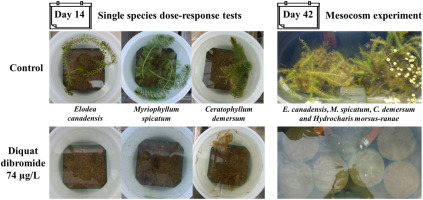Ecotoxicology and Environmental Safety ( IF 6.2 ) Pub Date : 2018-09-10 , DOI: 10.1016/j.ecoenv.2018.08.033 V. Sesin , R.L. Dalton , C. Boutin , S.A. Robinson , A.J. Bartlett , F.R. Pick

|
The herbicide diquat dibromide is used in North America to manage nuisance macrophytes. However, its effect on native macrophytes is less clear and it could cause indirect effects on other aquatic biota. This study determined the sensitivity of both native and non-native macrophytes grown in test systems with varying complexity to diquat dibromide applied directly to water following label directions. In an outdoor mesocosm experiment and single species greenhouse concentration-response tests, Elodea canadensis Michx., Myriophyllum spicatum L., Ceratophyllum demersum L. and Hydrocharis morsus-ranae L. were exposed to a range of diquat dibromide concentrations (4.7 – 1153 µg/L), corresponding to 0.4 – 100% of the recommended label rate of the formulated product. The mesocosm experiment contained all four plant taxa in the same system along with caged amphipods (Hyalella azteca Saus.), tadpoles (Lithobates pipiens Schreber), phytoplankton and periphyton; however, this study focuses on the macrophytes only. In both test systems, severe direct effects of diquat dibromide on macrophytes were detected, with almost 100% mortality of all macrophytes in both test systems at 74 µg/L. The most sensitive species in the single species tests, E. canadensis, showed almost 100% mortality at concentrations below the HPLC-based method detection limit of 5 µg/L. Effects occurred very rapidly and showed no difference in severity between native and non-native macrophytes or complexity of test systems. These results suggest that diquat dibromide could be applied at a considerably lower label rate, depending on the characteristics of the waterbody, while still achieving effective control of nuisance macrophytes.
中文翻译:

在不同复杂性的测试系统中,大型植物对除草剂双季铵盐二溴化物高度敏感
北美使用除草剂敌草快二溴化物来管理有害的大型植物。但是,其对天然大型植物的影响尚不清楚,它可能对其他水生生物造成间接影响。这项研究确定了在测试系统中生长的天然和非天然大型植物对按照标签指示直接施用于水中的敌草快二溴化物的敏感性。在室外围隔实验和单一物种温室浓度-响应测试,伊乐藻金樱子,狐尾藻属,金鱼藻L.和水鳖morsus-蟆L.暴露于一定范围的敌草快二溴化物浓度(4.7 – 1153 µg / L),相当于配方产品推荐标签率的0.4 – 100%。中观实验包含了同一系统中的所有四种植物类群,以及笼中的两栖动物(Hyalella azteca Saus。),t(Lithobates pipiens Schreber),浮游植物和附生植物。但是,这项研究仅针对大型植物。在两个测试系统中,均检测到了敌草快二溴二苯醚对大型植物的严重直接影响,两个测试系统中所有大型植物的死亡率几乎都为100 µg / L。单物种测试中最敏感的物种加拿大大肠埃希菌,在低于基于HPLC的方法检测极限5 µg / L的浓度下,显示出近100%的死亡率。效果发生得非常快,原生和非原生大型植物之间的严重程度没有差异,测试系统的复杂性也没有差异。这些结果表明,根据水体的特性,敌草快二溴化物可以以相当低的标记率使用,同时仍然可以有效控制有害的大型植物。











































 京公网安备 11010802027423号
京公网安备 11010802027423号